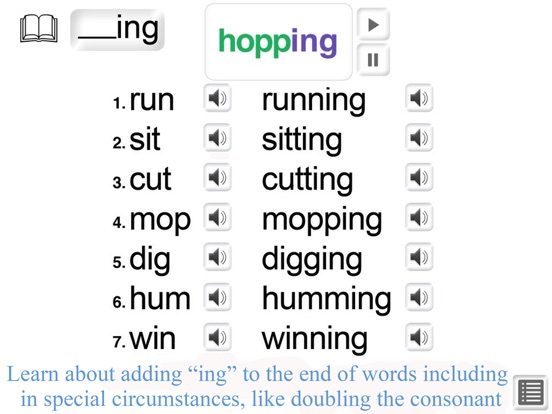What's New
This app has been updated by Apple to use the latest Apple signing certificate.
App Description
In this app, children first learn about the vowel team "ie" in words in which the two letters "ie" are together (like in "tie", "lie", and "died"). Next, they learn about this team when it is split with one consonant in the middle (like in "time", "bike", and "line"). For multiple reasons, we stick with the logic of seeing two letters working together as a team, rather than using terms like "silent e" or "magic e" and saying the "e" makes the first vowel "long" or "say its name". The primary reason we stick to calling "ie" a team even when there is a letter in the middle is consistency. These letters work as a team like all the other vowel teams. Also, we can stick to this logic when we teach about the many other times that words end in "e" when "e" is NOT making the first vowel say its name, like "se" at the end of "house", "ge" at the end of "large", "le" at the end of "little", and "ce" at the end of "fence". After children learn about the split "i_e" team, they get to practice picking whether "i_e" or "i" spells the missing sound in words, and then they read words with split "i_e".
Next we teach the split "a_e" team, like in "bake" and "made". Children then practice picking whether "a_e" or "a" spells the missing sound in words and read words with split "a_e". During the next two lessons, children learn about the two sounds the team "ue" and split "u_e" can represent (/oo/ like in "blue" and "tune", and /ue/ like in "cue" and "cute"). Children get to read words with these teams and then practice picking which sound these teams represent in words.
The letter "i" alone doesn't represent the sound /ie/ in the middle of consonant-vowel-consonant words, but if the sound /ie/ is followed by two consonant sounds, we just use the letter "i", like in "find" and "child". Children learn about these words in a short, fun video, and then they get to practice reading "ind" and "ild" words. Next we introduce adding "ing" and "ed" to words because these suffixes appear frequently in early reading books.
We have 18 vowel sounds but only five vowel letters plus the letter "y". Most vowel sounds can be spelled in multiple ways including by vowel teams (digraphs). Reading failure (dyslexia) occurs when children are not able to figure out this complicated system that even most adults don’t fully understand, so they resort to ineffective reading strategies. Children don’t need to struggle and fail! The Sounds Have Letter Teams apps make this complicated system very clear, easy, and quick to learn.
App Changes
- May 23, 2018 Initial release






























